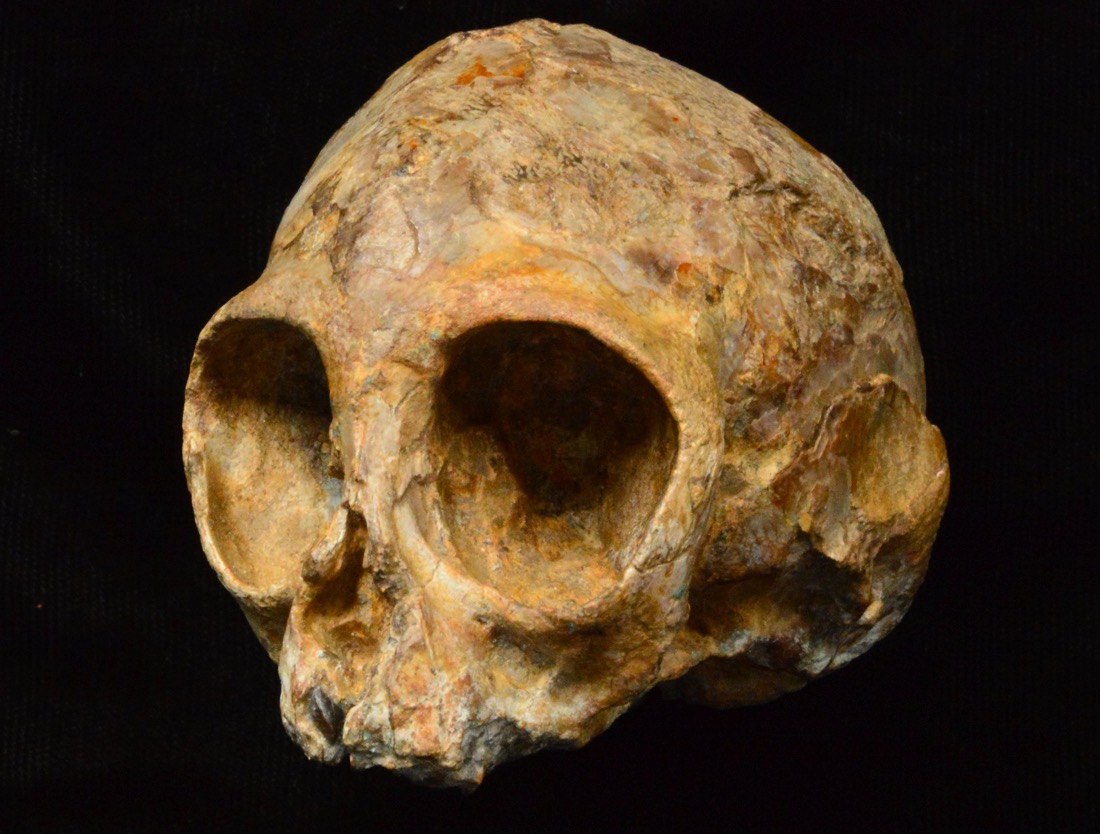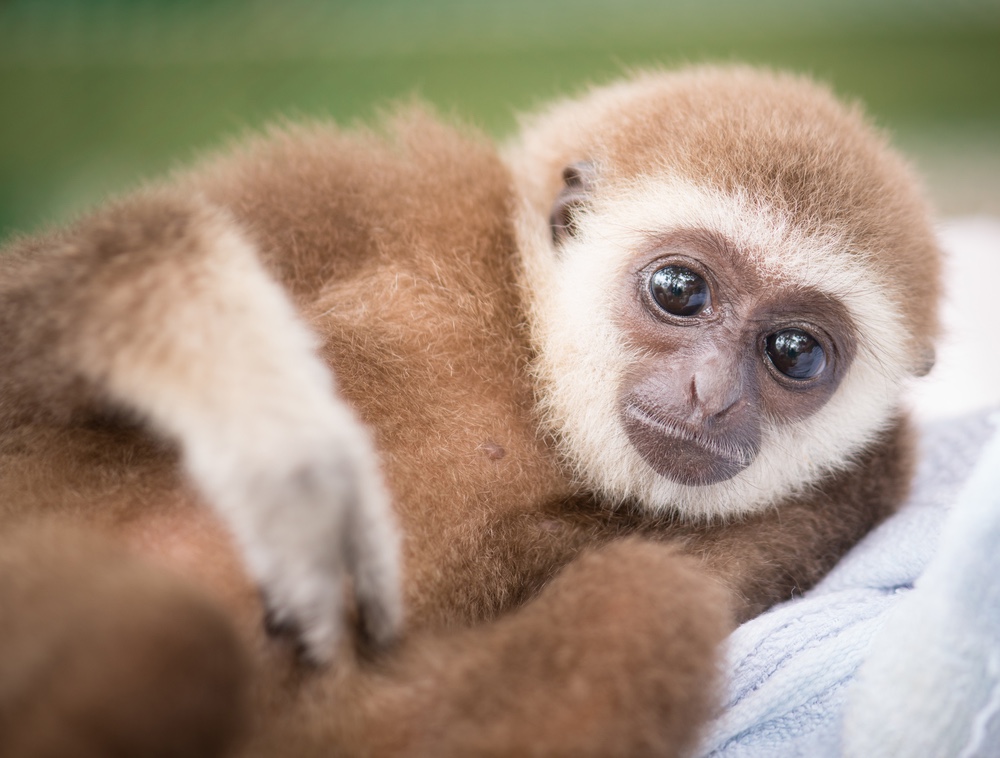Here's What the Last Common Ancestor of Apes and Humans Looked Like

The most complete extinct-ape skull ever found reveals what the last common ancestor of all living apes and humans might have looked like, according to a new study.
The 13-million-year-old infant skull, which its discoverers nicknamed "Alesi," was unearthed in Kenya in 2014. It likely belonged to a fruit-eating, slow-climbing primate that resembled a baby gibbon, the researchers said.
Among the living primates, humans are most closely related to the apes, which include the lesser apes (gibbons) and the great apes (chimpanzees, gorillas and orangutans). These so-called hominoids — that is, the gibbons, great apes and humans — emerged and diversified during the Miocene epoch, approximately 23 million to 5 million years ago. (The last common ancestor that humans had with chimpanzees lived about 6 million to 7 million years ago.)
Much remains unknown about the common ancestors of living apes and humans from the critical time when these branches diverged. Fossil evidence from this part of the primate family tree is scarce, and consists mostly of isolated teeth and broken jaw fragments. As such, researchers were not sure what the last common ancestors of living apes and humans might have looked like, and even whether they originated in Africa or Eurasia. [See Photos of Alesi and the Kenya Excavation Site]

"The living apes are found all across Africa and Asia — chimps and gorillas in Africa, orangutans and gibbons in Asia — and there are many fossil apes found on both continents, and Europe as well," study co-author Christopher Gilbert, a paleoanthropologist at Hunter College in New York, told Live Science. "So, as you can imagine, there are numerous possibilities for how that distribution came to be, and different researchers have suggested different hypotheses for where the common ancestor of the living apes and humans might be found."
Great timing
Kenyan fossil hunter John Ekusi discovered the skull in 2014 in the Napudet area, west of Lake Turkana in northern Kenya. He suggested its nickname, "Alesi," because "ales" means "ancestor" in the local Turkana language.
"The Napudet locality offers us a rare glimpse of an African landscape 13 million years ago," study co-author Craig Feibel, chair of the anthropology department at Rutgers University in New Jersey, said in a statement. "A nearby volcano buried the forest where the baby ape lived, preserving the fossil and countless trees. It also provided us with the critical volcanic minerals by which we were able to date the fossil."
Sign up for the Live Science daily newsletter now
Get the world’s most fascinating discoveries delivered straight to your inbox.
This is the first ape cranium unearthed from between 10 million and 14 million years ago, and the most complete one discovered from between 7 million and 17 million years ago. [In Photos: A Game-Changing Primate Discovery]
"Alesi came from exactly the right time and place to show us what the ancestors of all the modern apes and humans might have looked like," study co-author Ellen Miller, a primatologist and paleoanthropologist at Wake Forest University in Winston-Salem, North Carolina, told Live Science. "We never had information on that before — it was always a mystery."
It remains uncertain how Alesi died. However, perhaps the infant was killed by the thick layers of ash from huge volcanic eruptions that covered the fossil, the researchers said.
Baby primate looked like gibbon
The lemon-size skull still had the roots of its baby teeth, and none of the adult teeth had erupted from the jaw yet. The three-dimensional X-ray images taken of these adult teeth were so detailed that researchers could count their enamel layers, which were laid down over time like rings inside a tree, helping the scientists estimate that the baby primate was 16 months old when it died.
"From the teeth, we can tell it generally ate fruits," Miller said.
The shape of the unerupted adult teeth revealed that Alesi belonged to a genus, or group of species, known as Nyanzapithecus, a sister group to the hominoids that was discovered about 30 years ago. However, Alesi's teeth were much larger than those of other members of this genus, so the scientists declared that Alesi belonged to a new species, Nyanzipithecus alesi. ("Nyanza" is the province in western Kenya where the first specimen of Nyanzapithecus was found, and "pithecus" comes from the Greek word for "ape.")
"Nyanzapithecus alesi was part of a group of primates that existed in Africa for over 10 million years," lead study author Isaiah Nengo, of Stony Brook University in New York, said in the statement. "What the discovery of Alesi shows is that this group was close to the origin of living apes and humans, and that this origin was African."
Determining that the last common ancestors of living apes and humans originated in Africa is important because it helps scientists better understand how ancient climate, ecology, geography and other factors were key to their evolution. "It helps us understand and reconstruct how and why a certain lineage might have evolved," Gilbert said.
The researchers cannot tell if Alesi was male or female, as the infant was too young for the features of the skull that distinguish the sexes to have emerged, the researchers said. However, the size of the skull and teeth do suggest that if Alesi had reached adulthood, it would have weighed about 24.9 lbs. (11.3 kilograms) at maturity. The researchers also noted that Alesi's 6.16-cubic-inch (101 cubic centimeters) brain was about as big as that of a modern lemur of the same size.
The small snout of the skull would have made Alesi look like a baby gibbon. "Because they are probably close to the ancestor of all living apes, the specimen may help give us some sort of idea of what the common ancestor of all living apes and modern humans might have looked like, and because our specimen looks most similar to gibbons among living apes, it would potentially support the idea that the common ancestor of living apes and humans looked like a gibbon," Gilbert said.
However, the shape of Alesi's inner ear, which contains the balance organ of primates, suggests that Alesi was not capable of the rapid, acrobatic tree-swinging associated with gibbons.
"It probably had a more slow-climbing form of locomotion, more like [that of] a chimpanzee," Miller said.
The scientists detailed their findings in the Aug. 10 issue of the journal Nature.
Originally published on Live Science.










